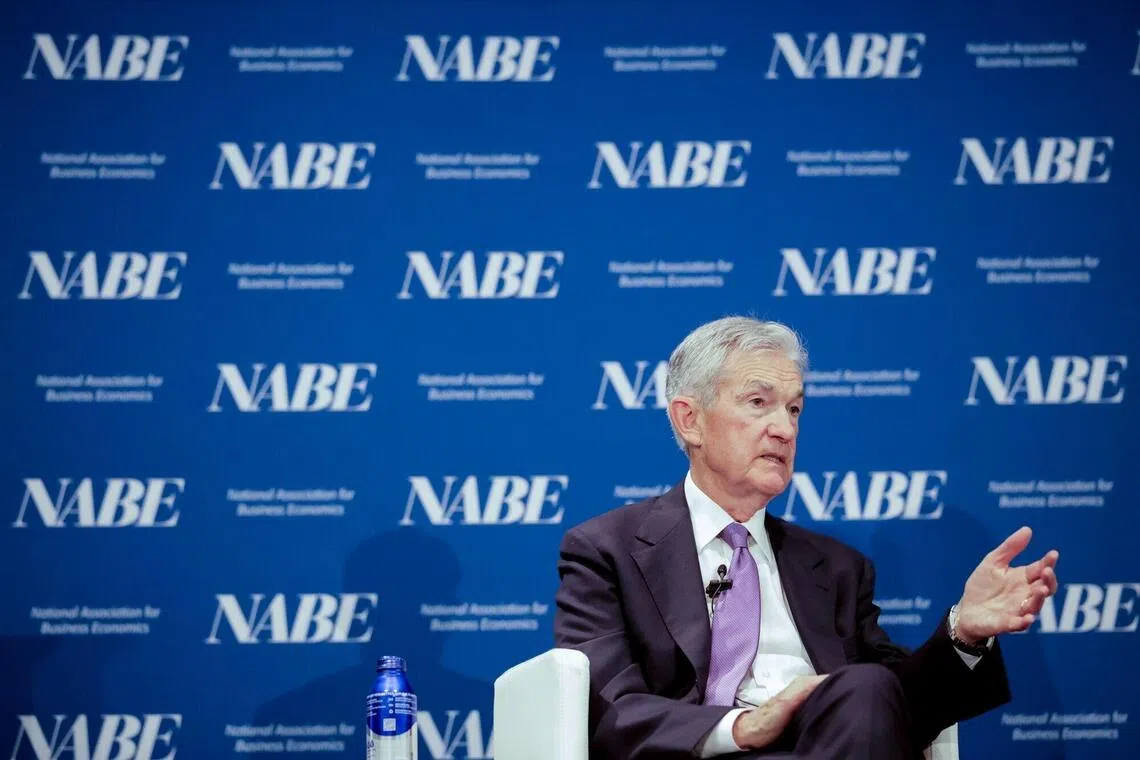US Treasury yields fall as Powell keeps rate cut bets alive
Sign up now: Get ST's newsletters delivered to your inbox

Federal Reserve chair Jerome Powell said the outlook for inflation and employment appears to have changed little since mid-September.
PHOTO: BLOOMBERG
Follow topic:
WASHINGTON – US Treasury yields fell to the lowest levels in weeks after Federal Reserve chair Jerome Powell’s comments left intact expectations for two more interest rate cuts by the end of 2025.
Following Mr Powell’s speech to business leaders in Philadelphia, yields fell as much as three basis points, led by shorter-dated tenors that are more sensitive to changes in monetary policy. The rate on benchmark 10-year notes dipped to 4.02 per cent, around levels last seen in early September.
The Fed chief said the outlook for inflation and employment appears to have changed little since officials’ last meeting in September, when they cut interest rates for the first time this year
Interest-rate swaps continue to show policymakers will reduce rates by a quarter-point at the October and December meetings.
Monetary policy expectations are “still signaling an October cut on the table, and the hurdle to change that is high”, said Mr John Briggs, head of US rates strategy at Natixis North America.
Swap contracts tied to the outcome of specific Fed policy meetings are pricing in close to 1.25 percentage points of easing by the end of 2026, from the current band of 4 per cent to 4.25 per cent.
The outlook has become murky, however, amid the dearth of economic data caused by a US government shutdown that began on Oct 1.
Still, Mr Powell said “available evidence suggests that both layoffs and hiring remain low, and that both households’ perceptions of job availability and firms’ perceptions of hiring difficulty continue their downward trajectories”.
Much of the speech was devoted to the Fed’s balance-sheet management, with implications for the relative value of Treasuries and interest-rate swaps.
The effect of those comments was to cheapen swaps relative to Treasuries, causing sharp moves in swap spreads. For example, the 30-year swap rate increased by nearly three basis points to about 3.88 per cent while the 30-year Treasury yield remained little changed.
The Fed since 2022 has been shrinking the size of its balance sheet by not replacing all of its maturing Treasury holdings, though it has lowered the redemption cap in stages, most recently to US$5 billion (S$6.5 billlion) a month.
Its plan – under discussion for years, most recently at the September meeting, according to the minutes – has been to stop the run-off when it determines that further drainage of reserves from the banking system could harm liquidity.
Mr Powell said on Oct 14 that point could be reached “in the coming months”, and the prospect of additional Fed demand for Treasuries, allowing smaller amounts to be raised from private investors, sparked a cheapening move in swaps.
“From a rates market perspective, it adds momentum to swap spreads – less negative in the long end,” said Mr Ed Al-Hussainy, portfolio manager at Columbia Threadneedle Investments. The firm has been “looking for this smoke signal on the balance sheet”.
Earlier on Oct 14, the trade policy flare-up hit stock markets globally, boosting demand for bonds despite the potential for protectionism to cause inflation. The British market led gains for European government debt after an unexpected increase in unemployment prompted traders to add to bets on further interest rate cuts from the Bank of England.
It’s “right back to trade shenanigans, downside growth risks,” said Ms Lauren van Biljon, senior portfolio manager at Allspring Global Investments, on Bloomberg TV. “There’s quite an aggressively priced US easing cycle.”
Markets tumbled on Oct 10 as US President Donald Trump threatened new tariffs on China,
The US 10-year yield dipped below 4 per cent for the first time in nearly a month, before rebounding. Its German counterpart dropped as much as five basis points to 2.58 per cent, the lowest level since July 4, while the UK’s rate sank seven basis points to 4.57 per cent, the lowest level since Aug 11.
Government bonds have retained their traditional role as a haven asset, even as concerns around deficits spur some money managers to pursue the so-called debasement trade. Its adherents are pulling away from sovereign debts – and the currencies they are denominated in – due to concerns that their value will be eroded over time, opting instead for precious metals and cryptocurrencies.
Gold climbed to a fresh record on Oct 15, rising to a fresh peak of US$4,185 an ounce.
Bitcoin fell as much as 5 per cent to around US$110,000 on Oct 14.
West Texas Intermediate crude dropped towards US$57 a barrel, and the S&P 500 index rebounded from a 1.5 per cent decline.
“The drop in equities and commodities is a clear sign of risk aversion,” said Ms Kathleen Brooks, research director at XTB. “Money is instead moving into sovereign bonds.” BLOOMBERG

